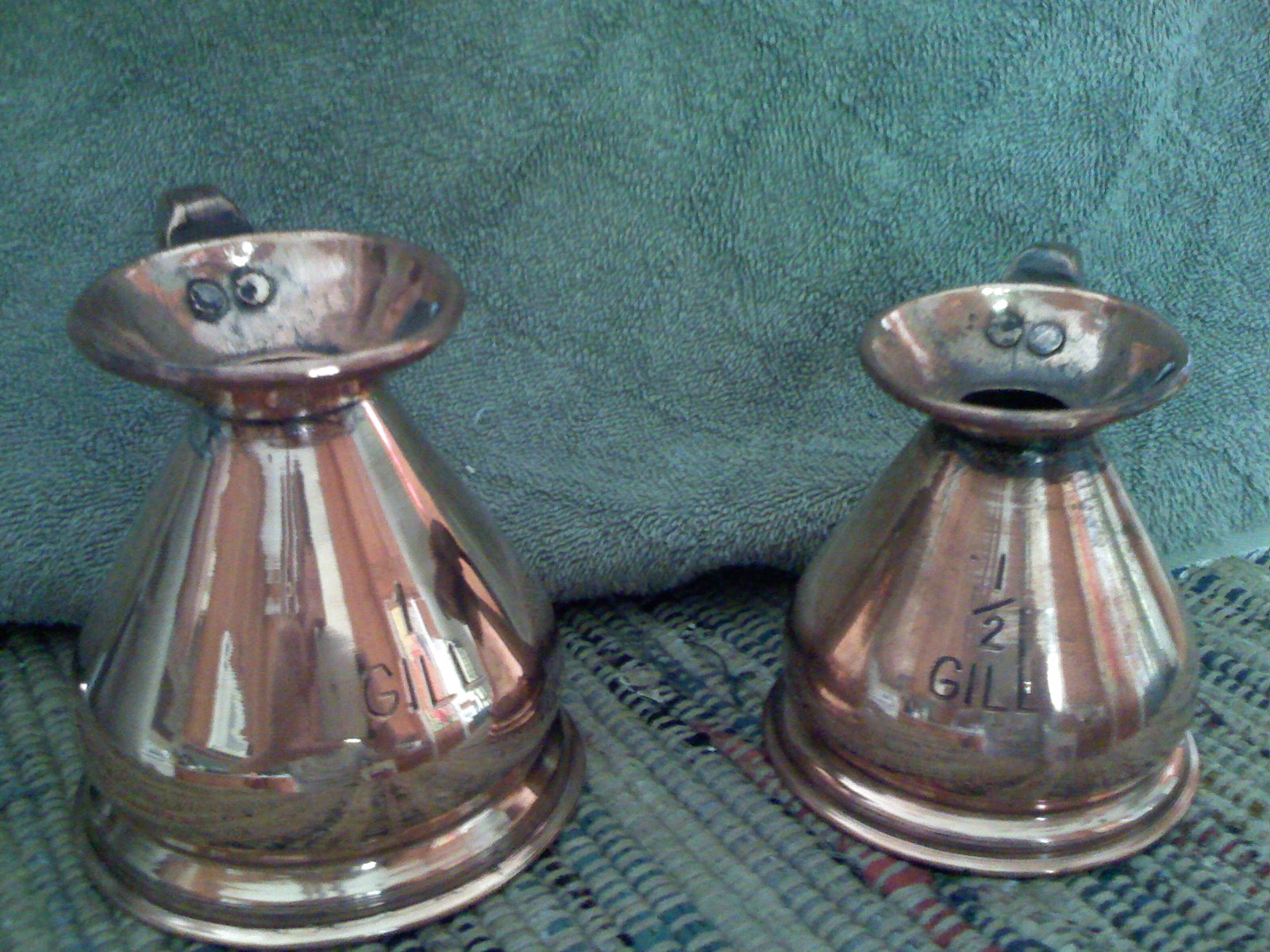|
Mutchkin
''Disambiguation: a "mutchkin" can also refer a close-fitting Scottish cap''. The mutchkin () was a Scottish unit of liquid volume measurement that was in use from at least 1661 (and possibly as early as the 15th century) until the late 19th century, approximately equivalent to 424 mL, or roughly imperial pint. The word was derived from – a mid 15th-century Dutch measure of beer or wine. *A mutchkin could be subdivided into four Scottish gills (of approximately 106 mL each) – this was roughly equivalent to three imperial gills or three-quarters of an imperial pint. *Two mutchkins (848 mL) made one chopin. *Four mutchkins (1696 mL) made one Scottish pint (or ''joug''), roughly equivalent to three imperial pints (1705 mL).* See also * Obsolete Scottish units of measurement Scottish or Scots units of measurement are the weights and measures peculiar to Scotland which were nominally replaced by English units in 1685 but continued to be used in ... [...More Info...] [...Related Items...] OR: [Wikipedia] [Google] [Baidu] |
Obsolete Scottish Units Of Measurement
Scottish or Scots units of measurement are the weights and measures peculiar to Scotland which were nominally replaced by English units in 1685 but continued to be used in unofficial contexts until at least the late 18th century. The system was based on the ell (length), stone (mass), and boll and firlot (volume). This official system coexisted with local variants, especially for the measurement of land area. The system is said to have been introduced by David I of Scotland (1124–53), although there are no surviving records until the 15th century when the system was already in normal use. Standard measures and weights were kept in each burgh, and these were periodically compared against one another at "assizes of measures", often during the early years of the reign of a new monarch. Nevertheless, there was considerable local variation in many of the units, and the units of dry measure steadily increased in size from 1400 to 1700... The Scots units of length were technica ... [...More Info...] [...Related Items...] OR: [Wikipedia] [Google] [Baidu] |
Chopin (unit)
The chopin was a Scottish measurement of volume, usually for fluids, that was in use from at least 1661, though possibly 15th century, until the mid 19th century.* The measurement was derived from the French measure ''chopine'' an old and widespread unit of liquid capacity, first recorded in the 13th century. A chopin is equivalent to 0.848 litres. * 1 chopin is 8 gills * 1 chopin is 2 mutchkins * 2 chopins is the equivalent of 1 (Scots) pint (or joug) * 16 chopins is the equivalent of 1 (Scots) gallon References See also * Obsolete Scottish units of measurement Scottish or Scots units of measurement are the weights and measures peculiar to Scotland which were nominally replaced by English units in 1685 but continued to be used in unofficial contexts until at least the late 18th century. The system was ... Obsolete Scottish units of measurement Units of volume 17th-century establishments in Scotland 17th-century introductions 19th-century disestablishments in Scotland ... [...More Info...] [...Related Items...] OR: [Wikipedia] [Google] [Baidu] |
Pint (Scots)
The joug or Scots pint or Scottish pint () was a Scottish unit of liquid volume measurement that was in use from at least 1661 – possibly as early as the 15th century – until the early 19th century, approximately equivalent to 1696 mL or roughly three imperial pints. The standard was held at Stirling Stirling (; ; ) is a City status in the United Kingdom, city in Central Belt, central Scotland, northeast of Glasgow and north-west of Edinburgh. The market town#Scotland, market town, surrounded by rich farmland, grew up connecting the roya ... and thereby called the Stirling Jug. It went astray in 1745 and its loss was hidden by replacement by a standard pewter jug of roughly the same size. The error was discovered by Rev Alexander Bryce in 1750, who after a long search found the damaged jug in the attic of a Mr Urquhart, a coppersmith in Stirling, and restored the standard. Bakers used the measure until the late 19th century. * One joug was sixteen Scottish gills ... [...More Info...] [...Related Items...] OR: [Wikipedia] [Google] [Baidu] |
Scotland
Scotland is a Countries of the United Kingdom, country that is part of the United Kingdom. It contains nearly one-third of the United Kingdom's land area, consisting of the northern part of the island of Great Britain and more than 790 adjacent Islands of Scotland, islands, principally in the archipelagos of the Hebrides and the Northern Isles. To the south-east, Scotland has its Anglo-Scottish border, only land border, which is long and shared with England; the country is surrounded by the Atlantic Ocean to the north and west, the North Sea to the north-east and east, and the Irish Sea to the south. The population in 2022 was 5,439,842. Edinburgh is the capital and Glasgow is the most populous of the cities of Scotland. The Kingdom of Scotland emerged as an independent sovereign state in the 9th century. In 1603, James VI succeeded to the thrones of Kingdom of England, England and Kingdom of Ireland, Ireland, forming a personal union of the Union of the Crowns, three kingdo ... [...More Info...] [...Related Items...] OR: [Wikipedia] [Google] [Baidu] |
Gill (unit)
__NOTOC__ The gill or teacup is a unit of measurement for volume equal to a quarter of a pint. It is no longer in common use, except in regard to the volume of alcoholic spirits measures. Imperial ;In imperial units: : US ;In United States customary units: : United Kingdom Prior to metrication in the United Kingdom, the standard single measure of spirits in a pub was in England and Wales, either or in Scotland, and in Northern Ireland. After metrication, this was replaced by measures of either , at the discretion of the proprietor. Half of a gill is a jack, or one-eighth of a pint. But in northern England, a quarter pint could also be called a jack or a noggin, rather than a gill, and in some areas a half-pint could be called a gill, particularly for beer and milk. In Scotland, there were additional sizes: * big gill = * wee gill = * wee half gill = * nip = Ireland In the republic of Ireland, the standard spirit measure was historically gill. It stil ... [...More Info...] [...Related Items...] OR: [Wikipedia] [Google] [Baidu] |
Imperial Pint
The pint (, ; symbol pt, sometimes abbreviated as ''p'') is a unit of volume or capacity in both the imperial and United States customary measurement systems. In both of those systems, it is one-eighth of a gallon. The British imperial pint is 20.095% larger than the US pint because the two systems are defined differently. Almost all other countries have standardized on the metric system, so although some of them still also have traditional units called pints (such as for beverages), the volume varies by regional custom. The imperial pint (≈) is used in Ireland, the United Kingdom, and other Commonwealth countries. In the United States, two kinds of pint are used: a liquid pint (≈) and a less common dry pint (≈). Other former British colonies, such as Australia, South Africa and New Zealand, converted to the metric system in the 1960s and 1970s, so while the term may still be in common use in these countries, it may no longer refer to the British imperial pint once ... [...More Info...] [...Related Items...] OR: [Wikipedia] [Google] [Baidu] |
Units Of Volume
A unit of volume is a unit of measurement for measuring volume or capacity, the extent of an object or space in three dimension (mathematics), dimensions. Units of capacity may be used to specify the volume of fluids or bulk goods, for example water, rice, sugar, grain or flour. Units According to the International System of Units, SI system, the base unit (measurement), base unit for measuring length is the metre. The SI unit of volume is thus the cubic metre, which is a derived unit, where: at nist.gov. Retrieved 29 June 2022. 1 m3 = 1 m • 1 m • 1 m. Comparison Forestry and timber industry British Commonwealth * Hoppus, cubic foot measure used in the Bri ...[...More Info...] [...Related Items...] OR: [Wikipedia] [Google] [Baidu] |


